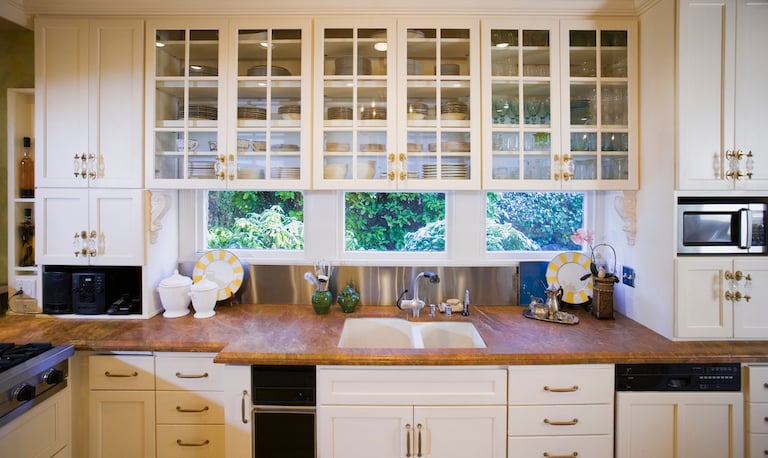The Ultimate Guide to Kitchen Cabinet Door Styles
Choosing the right cabinet doors can instantly elevate your kitchen's aesthetic


Updating your cabinet doors is a simple, relatively inexpensive way to transform your kitchen's aesthetic. But before deciding on the right cabinet door for your space, it helps to review the best styles on the market right now. Whether you love the idea of glass doors to display your favorite dishware or you want a minimal, flat-paneled door to complement your pared-back aesthetic, these are the nine most popular cabinet door styles.
1. Glass
If you have any fine china, sentimental vintage glasses, or other display-worthy kitchen pieces, let them shine with glass-front cabinet doors. In addition to showcasing your favorite dishware, glass-front cabinets can help break up the heavy appearance that often accompanies a large section of solid cabinetry. Many people use them as accents rather than outfitting all of their cabinets with them—we all need a place to hide our mismatched Tupperware and stacks of sippy cups, right?
2. Shaker
Named for the shaker-style furniture that originated in the 18th century, shaker cabinet doors feature a clean, streamlined look that complements a variety of kitchen styles. Their five-piece design includes a basic, four-piece frame and one flat center panel. With their elegantly simple appearance, these doors are a great option for anyone seeking a timeless design that will look great for years to come. They can also easily be dressed up with pretty paint colors and fun hardware, depending on your style preferences.
3. Flat
Minimalists will love flat-panel cabinet doors for their pared-back appearance. These doors are similar to shaker-style doors, except flat-panel doors only have a single flat panel rather than a center panel and a border. Their sleek appearance makes them ideal for contemporary aesthetics, but they're versatile enough to complement many other looks as well. You can also choose between flat-panel cabinets with hardware or opt for no hardware at all for a fully minimalist look.
4. Louvered
Louvered cabinet doors are composed of many horizontal wood slats. These slats offer ventilation that can be particularly beneficial if you live in a humid climate susceptible to mold. They also provide lots of texture and visual intrigue, offering a dynamic, interesting look without excessive ornamentation.
5. Distressed
Ideal for rustic, farmhouse, and shabby-chic aesthetics, distressed cabinet doors come in many styles, such as shaker and louvered. When you order distressed doors, the manufacturer will use various techniques, such as sanding, to create a worn appearance. But don't let these doors' distressed appearance fool you into thinking they come cheap—like those holey jeans you shelled out for in high school, they typically cost more than standard doors due to the added work to achieve the look.
6. Beadboard
Beadboard cabinet doors feature several rows of vertical planks, with each separated by a ridge or indentation called a "bead." Like louvered doors, these cabinet doors are a great way to add textural layers to your aesthetic. However, their narrow crevices can be tough to clean, so plan on using some extra elbow grease if you opt for this style.

7. Melamine
If you're looking for a budget-friendly update, then melamine cabinet doors are a great option. Molded from heat-sealing medium-density fiberboard, pressed wood, or plywood, they're cheaper than wood doors but often have a very similar appearance. In fact, you can even purchase options with faux wood grain. The potential drawback to these doors is that if they're damaged, they're pretty tricky, if not impossible, to repair.
8. Inset
Inset doors are nested within a cabinet's frame rather than resting on top of it. These doors are typically more expensive than alternatives because they need to be very precisely designed and constructed to fit inside the frame. But they have a special knack for creating beautiful, streamlined looks, so for many people, they're a worthwhile investment.
9. Custom
Still can't decide on a cabinet door? Then custom doors might be your best bet. Going the custom route allows you to incorporate cabinet doors that fit your unique needs and style. And you don't have to be a designer to get a great design. Many local craftspeople and designers are happy to help customers pick just the right colors, materials, and overall designs for their unique style needs.



















